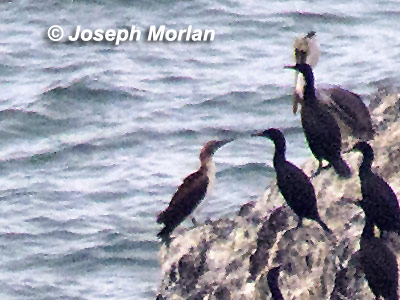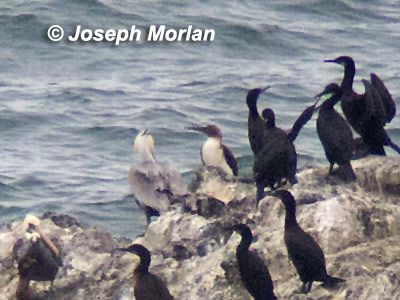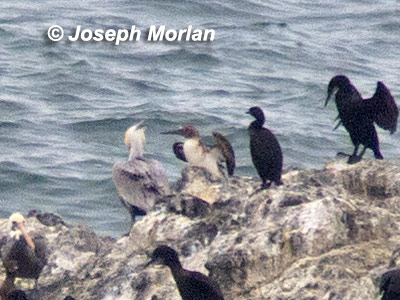
After landing on left side of rock.
Blue-footed Booby (Sula nebouxii nebouxii)
Gull Rock, Stinson Beach, Marin Co, CA
10 October 2013
Joseph Morlan
Photos © 10 October 2013 by Joseph Morlan. All rights reserved. Click here for larger images.

After landing on left side of rock.
I believe this species was found here by Jim White on 24 September who saw two birds. At least one bird has been fairly reliable since then. Dan Singer and I arrived about 8:30am and Dan spotted the bird perched behind cormorants on top of Gull Rock. This is over a third of a mile distant from our vantage point along Highway one. The bird flew around and landed several times before disappearing behind the rock. It spent much time preening and hidden behind other birds. I attempted to digiscope it with the results seen here.

Top of Gull Rock.
Description
The following description is based on memory and on photos:
This booby was slightly smaller than adjacent Brandt's Cormorants (Phalacrocorax penicillatus). The bird spent much time actively preening, but flew out over the ocean several times and returning to perch on Gull Rock. It had a large, dark-gray cone-shaped bill, long pointed tail and very long pointed wings. The uppeparts were mostly brown with the upperside of the wings fairly solid brown, showing some pale mottling on the coverts in flight. The back of the neck had an obvious large white patch mostly visible in flight, that separated the back from the head. The forehead had a narrow white band visible ontly through the scope. The lower back had a bold white patch separating the back from the dark brown rump. The long pointed tail-feathers were paler. The underparts were white. The underwings were sometimes seen briefly while the bird preened or spread its wings. They seemed to be white in the axillars and inner portion of the underwing. One photo seems to show a trace of a narrow dark bar within the white of the secondary underwing coverts. Legs and feet were gray.

Wings spread briefly.
Discussion
Status in California
Until this year, there were 114 previously accepted records of Blue-footed Booby in California. The species was removed from the CBRC review list in 1974 because it was thought to be of regular occurrence. It was restored in 1986 when it became apparent it was no longer a regular or expected visitor to the state. Major invasions occurred in 1969 (32 birds) and 1972 (at least 45 birds), but over 40 years have passed since then. Now we are experiencing what appears to be the largest invasion ever with more than 100 birds at the Salton Sea, more than 10 on Anacapa Island and up to 7 at Playa Del Rey. Birds have been seen as far north as Bodega Head in Sonoma County, and one was reportedly photographed at Mono Lake. An eBird summary is here. John Puschock discussed this event in the ABA Blog and more recently this incursion has been summarized on the Farallon blog.
There has been considerable speculation about the cause of this invasion. It seems likely to be related to a combination of high reproductive success followed by declines in food resources. Sardine stocks may have been over-fished in the Gulf of California. There have also been reports of declines in anchovy off the California Coast but other reports contradict this.
Age
All the California birds appear to be HY (hatching year) suggesting that there was a good reproductive season. I believe that this bird is mostly in juvenal plumage suggested by the dark head.
Marin County Status
The first record for Marin County, was a bird photographed at the Point Reyes Lighthouse on 11 September with two birds seen there 19 September. A single was seen at nearby Chimney Rock 20-21 September. One was reported at the mouth of Tomales Bay 5 October 2013.
Identification
The pattern of white patches on the upper and lower back and pale uppertail coverts help distinguish Blue-footed Booby from any similar species. Juvenile Peruvian Booby can be similar but usually has darker underparts and lacks the distinct white patches on the back. Two races of Blue-footed Booby are recognized. California birds have been assigned to the nominate race. S. n. excisa is slightly smaller and confined to the Galapagos Islands.